–Karline Jensen, High Rocks, Hillsboro, WV
Yesterday we visited Tommye and Richard Rafes’ Farm, T. L. Fruits and Vegetables, in Organ Cave, WV, for a High Tunnel Field Day hosted by Lewis Jett. Tommye and Richard received a SARE grant called Here Comes the Sun: Solar Power as Energy Source in Remote High Tunnel Ventilation Systems. It’s important to keep the temperatures inside the high tunnel even in order to prevent spikes and drops in growth. During the fall, winter, and spring, when Tommye’s high tunnels are in full production, this can be a challenge because the sun, wind, and outdoor temperatures can fluctuate greatly from day to day and even within the same day. Many high tunnel growers have jobs off the farm and are not available to adjust the ventilation constantly throughout the day. Even if they are usually home all day, it can be quite a chore, and there will always be days when they may want to travel out of town.
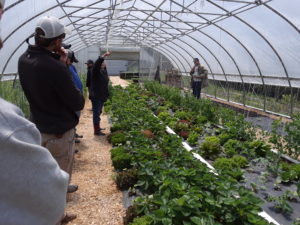
SARE, or Sustainable Agriculture Research and Education, provides grants and education to advance innovations in sustainable agriculture, with funding awarded through the USDA. Tommye and Richard wanted to show that using solar energy is a viable way to automate the ventilation in a high tunnel. We visited their three high tunnels and Richard explained the three different systems they had compared for ventilation. One was entirely manual, the second was powered by AC electricity, and the third was solar-powered. Tommye had recorded the sellable and unsellable weights she had produced from identically planted plots of spinach, kale, and collards in each of the three tunnels. She said they all produced about the same amount, which means that the automated systems performed just as well as herself running out to adjust the ventilation 3-4 times a day throughout the winter in wind and snow. She has a monitor in the house that notifies her when to go out and open or close it.
Richard showed us how to roll down the sides of the manually operated high tunnel using a crank. He said one drawback of the manual cranks is that they will get rusty and his first one broke after only five years. The vertical lines that guide the sides every so often can also eventually break or get stuck. The automated sides roll up rather than down. One improvement of this is that when the sides are rolled down, they can collect rainwater. With the roll up sides, they will catch less water if you roll them inward rather than outward. Richard said that when you cut the plastic and attach it to the piece it rolls around, make sure to cut the plastic longer than you think it needs to be so that it will still be rolled around a couple times when it is all the way down. That will help it not to get stuck. You can adjust the motors on the automated sides to have them go up and down to exactly where you want open and closed to be set. Richard cautioned that if it snows, you have to make sure to turn the system off until you have a chance to remove the snow, because if it’s frozen in spots the motors can twist and break the pipe.
They got all the components for their automated systems from Advancing Alternatives. The controllers can turn on and off up to 4 pieces of equipment including the two roll up sides, each at different temperatures. They also have a humidity sensor which is set to open the sides when it’s to humid, unless it’s below 40. And a wind gauge will close the sides to protect the structure in case of high winds. They had damage to their high tunnels a few years ago when we had the derecho. They could also use the wind gauge to close only one side it it’s windy, to shelter the plants.

For the solar powered high tunnel, they got a gel cell battery, which Richard recommended because it can last 4-5 days without sun and won’t be ruined by a deep discharge the way regular flooded batteries would. He keeps the battery in an ordinary Coleman cooler that he drilled some holes in for ventilation to let the hydrogen gas escape. The solar powered high tunnel even has a DC powered fan to blow air between the plastic layers. Richard built his own stand for the solar panel, but you can get one that mounts to a metal post. In the future, to improve the ventilation even more, they would like to add exhaust fans with automatic louvers on the end walls. The ultimate would be an automatically opening ridge vent.
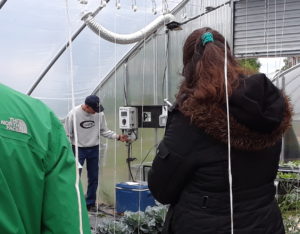
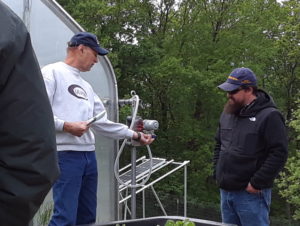
Tommye direct seeded her spinach in 4 rows a foot apart with about an 8″ spacing between plants, and harvested about 10 pounds per week out of each 10 foot long plot. She transplanted her kale and collards on August 4 and had just finished her last harvest from them when we visited. She will have kale in the high tunnel all summer, and also bok choy, but it gets too hot inside for lettuce. She grows all her lettuce and greens in landscape fabric with little holes in it that she reuses every year. She says the fabric helps to keep the greens clean, and she just lifts the entire piece up whenever she’s in between crops and it’s time to add more compost. She also told us about her trellising method for cucumbers. She prunes them to one stem, and then trains them around strings tied to the rafters of the high tunnel.
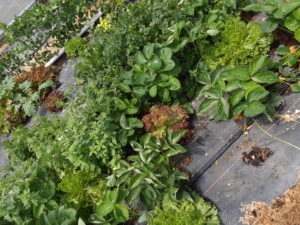


Tommye said that the SARE grant was a great way to get funding to help her to be able to install the ventilation system she had always wanted. In general, they will pay 1/3 of infrastructure costs for equipment that is necessary to conduct the proposed research, and they also provide funding to help pay for her salary, wages of helpers, travel, printing, postage, any consultants, even conferences, to the extent they are part of the research project. They require a letter of support, and a technical advisor for the project, and at the end you are expected to do outreach to share your findings with the public, which is how we ended up getting this detailed tour.
Richard said that Rimol, Puckett, and Yoder are all good manufacturers of high tunnels. He recommended using polycarbonate instead of plastic for the end walls because you can’t accidentally poke a hole in them, and also for the ends of the sides that overlap the rollup sides, because it lets them go up and down easier. He also recommended using all metal framing instead of wood, and to use a bag of concrete for every post, two for the end posts. Tommye and Richard also received funding from NRCS, which helped them to build the high tunnels and also to install an irrigation system including five tanks that each hold 1-2000 gallons of rainwater that they collect from all the high tunnels, from the barn, and from their house. They didn’t use gutters on the high tunnels. Instead, they buried perforated pipes next to them, and these collect the water and send it into the tanks.
Richard is planning a new project where he’s going to use geothermal to heat a 30′ x 96′ high tunnel. He plans to use 20 solar panels (total 2.8kW) and 4 batteries to power 6 65W fans to move 55 degree geothermal heat into the high tunnel all winter long. He’ll be digging eight feet deep under the entire site where the high tunnel will be built, in order to lay three sets of 14 30′ long pipes, with rock and dirt filled in between each set. If he hits rock before he gets eight feet deep, he plans to fill upwards instead, and insulate with 2″ of insulation all around the perimeter. The 14 pipes in each set will be 3″ corrugated, and will come up into the high tunnel in two of the corners and in the middle. During the summer the geothermal will be able to cool the high tunnel since 55 degrees will be a cooler temperature at that time of year.
Lewis Jett recommended some specific varieties for high tunnel growing that he said we should grow more of here in West Virginia: Mortgage Lifter and Hillbilly Tomatoes, Fortex Pole Beans, Winterbor Kale, Joy Choi Bok Choy, and Corvair Spinach. He wants to see more and more high tunnels in West Virginia, and he recommends big ones. He says bigger is better for easier climate control and more even temperatures.
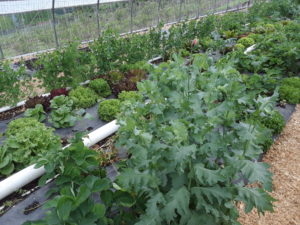

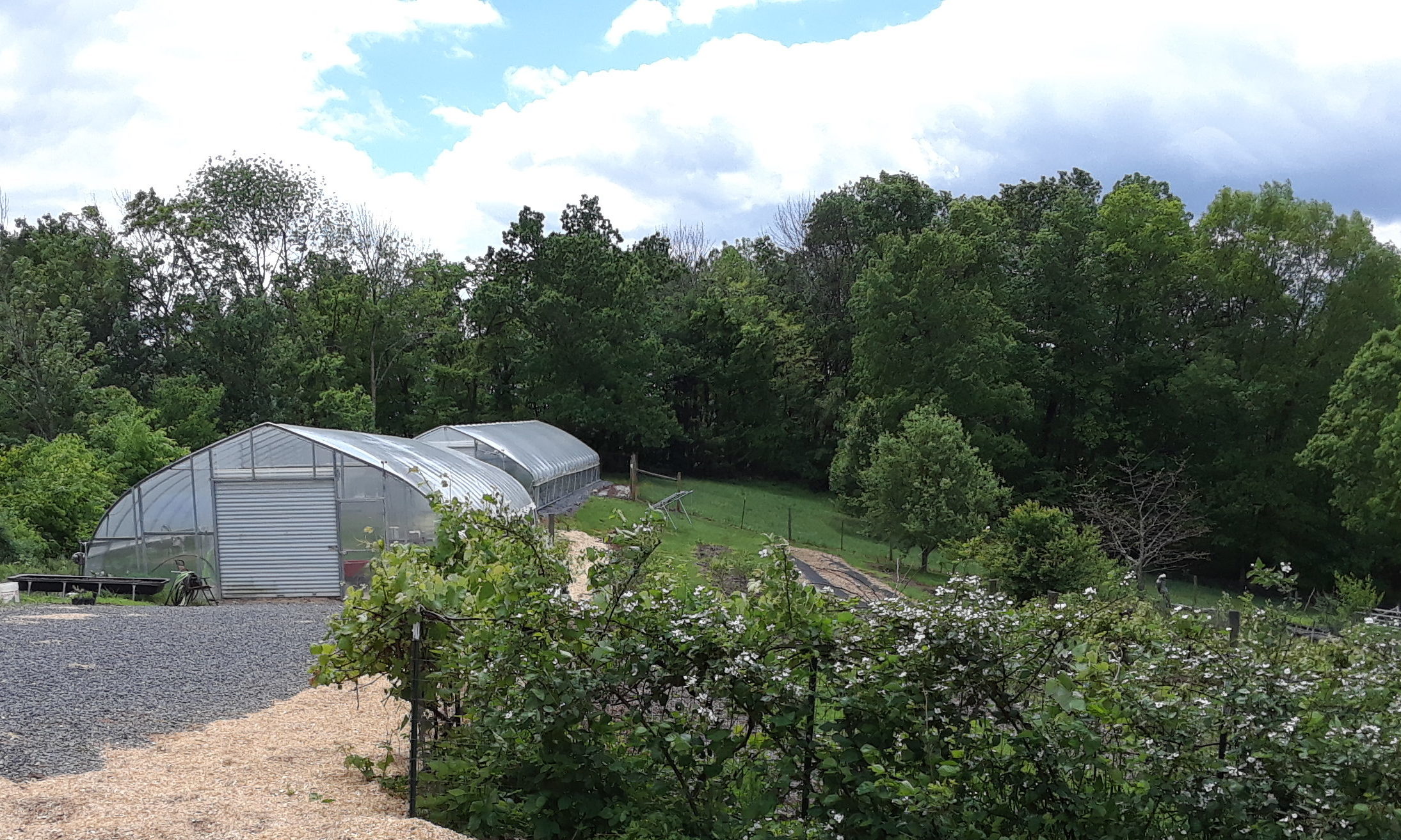

Thank you for visiting and giving a detailed summary.